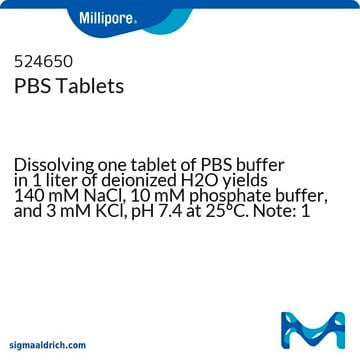P4809
Phosphate-Citrate Buffer
tablet
Sinônimo(s):
PCR Buffer
Faça loginpara ver os preços organizacionais e de contrato
About This Item
Código UNSPSC:
12161700
NACRES:
NA.25
Produtos recomendados
forma
tablet
pH
4.5-5.5 (1 tablet/100mL in water)
solubilidade
water: soluble
temperatura de armazenamento
room temp
Descrição geral
Phosphate-citrate buffer is a common buffer used along with soluble horseradish peroxidase substrates such as o-phenylenediaminedihydrochloride (OPD) or tetramethylbenzidine (TMB). It gives a pH of 5.0 with an excellent buffering capacity. The phosphate-citrate buffer tablets can be used to prepare a 0.05 M phosphate-citrate, pH 5.0, buffer solution. These tablets elicit a fast, convenient, and accurate method for the synthesis of phosphate citrate buffer solutions. They remove the time-consuming and tedious process of weighing individual components in buffer preparation. Phosphate-citrate buffer tablets have been manufactured from the highest quality components to exacting physical and chemical specifications to ensure performance and lot-to-lot consistency. Phosphate-Citrate Buffer tablets, pH 5.0, have been formulated as a substrate buffer in immunoassay procedures.
Aplicação
- Characterization of nettle leaves (Urtica dioica) as a novel source of protease for clotting dromedary milk by non-destructive methods.: This study uses phosphate-citrate buffer in the enzymatic extraction processes to maintain stability and activity of plant-derived enzymes, demonstrating its crucial role in the development of natural coagulants for dairy products (Bouazizi et al., 2022).
- A rapid, low pH, nutrient stress, assay to determine the bactericidal activity of compounds against non-replicating Mycobacterium tuberculosis.: Utilizing phosphate-citrate buffer, this study develops a low pH nutrient stress assay for evaluating the efficacy of antibacterial agents against dormant tuberculosis bacteria, providing a critical tool for drug development (Early et al., 2019).
- Measurement of Free Iodine in Different Formulations of Povidone-Iodine Eye Drops 5.: This investigation uses phosphate-citrate buffer to measure the stability and release of iodine in ophthalmic solutions, highlighting its importance in ensuring the efficacy and safety of eye care products (Prado et al., 2019).
Reconstituição
One tablet dissolved in 100 mL deionized water yields a 0.05 M phosphate-citrate buffer, pH 5.0, at 25 °C. Store at room temperature.
Palavra indicadora
Warning
Frases de perigo
Declarações de precaução
Classificações de perigo
Eye Irrit. 2 - STOT SE 3
Órgãos-alvo
Respiratory system
Código de classe de armazenamento
11 - Combustible Solids
Classe de risco de água (WGK)
WGK 3
Ponto de fulgor (°F)
Not applicable
Ponto de fulgor (°C)
Not applicable
Certificados de análise (COA)
Busque Certificados de análise (COA) digitando o Número do Lote do produto. Os números de lote e remessa podem ser encontrados no rótulo de um produto após a palavra “Lot” ou “Batch”.
Já possui este produto?
Encontre a documentação dos produtos que você adquiriu recentemente na biblioteca de documentos.
Os clientes também visualizaram
In vivo experimental model of orthotopic dental pulp regeneration under the influence of photobiomodulation therapy.
Maria Stella Moreira et al.
Journal of photochemistry and photobiology. B, Biology, 166, 180-186 (2016-12-09)
Antonino Tuttolomondo et al.
Oncotarget, 8(37), 61415-61424 (2017-10-06)
Anderson-Fabry disease (AFD) is an inborn lysosomal enzymopathy resulting from the deficient or absent activity of the lysosomal exogalactohydrolase, α-galactosidase A. This deficiency, results in the altered metabolism of glycosphingolipids which leads to their accumulation in lysosomes, thus to cellular
Rose, N., et al.
Manual of Clinical Laboratory Immunology, 106-106 (1986)
Ross R Keller et al.
Carcinogenesis, 37(8), 810-816 (2016-05-22)
Carcinogen exposures inscribe mutation patterns on cancer genomes and sometimes bias the acquisition of driver mutations toward preferred oncogenes, potentially dictating sensitivity to targeted agents. Whether and how carcinogen-specific mutation patterns direct activation of preferred oncogenes remains poorly understood. Here
P R Garrido et al.
Journal of photochemistry and photobiology. B, Biology, 194, 149-157 (2019-04-08)
Photobiomodulation therapy (PBMT) and the cell sheet (CS) technology improve processes relevant to tissue regeneration. The aim of this study was to investigate the effects of different PBMT parameters on the architecture (histology), protein composition (Western blotting and immunohistochemistry) and
Nossa equipe de cientistas tem experiência em todas as áreas de pesquisa, incluindo Life Sciences, ciência de materiais, síntese química, cromatografia, química analítica e muitas outras.
Entre em contato com a assistência técnica










